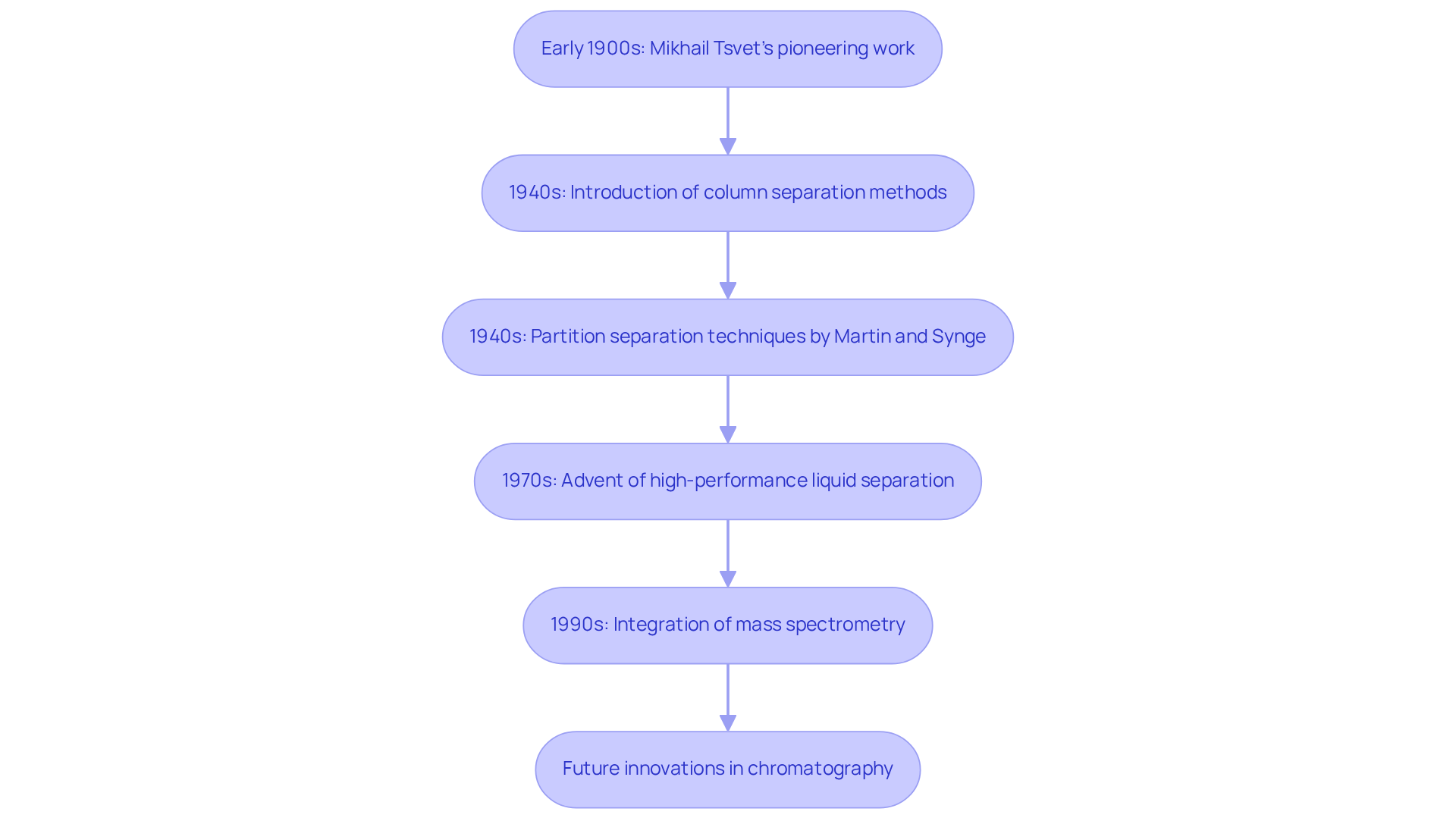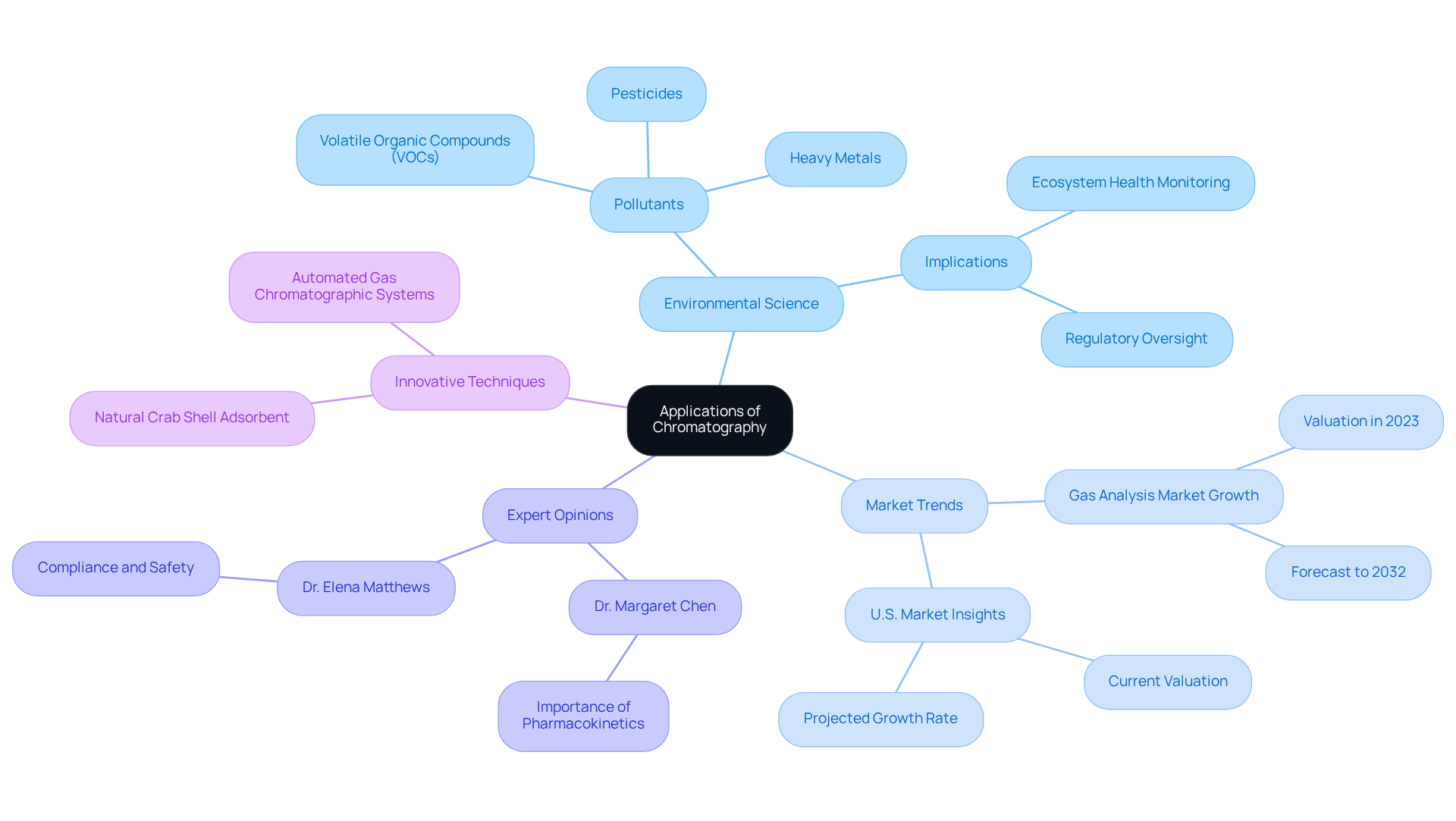Overview
The article delves into the multifaceted applications of chromatography within the scientific realm, highlighting its pivotal role in the separation of mixtures for analytical purposes across diverse fields such as:
- Pharmaceuticals
- Environmental science
- Food safety
It articulates how chromatography techniques, particularly advancements like high-performance liquid chromatography (HPLC), are indispensable for ensuring the purity of substances, detecting pollutants, and upholding regulatory compliance in various industries. This underscores the critical nature of high-quality scientific instruments in laboratory settings, ultimately reinforcing the importance of chromatography in maintaining standards and safeguarding public health.
Introduction
The intricate world of chromatography stands as a cornerstone across various scientific disciplines, enabling the precise separation of complex mixtures into their individual components. As technological advancements continue to refine these methods, the applications of chromatography extend far beyond the laboratory, permeating fields such as pharmaceuticals, environmental science, and food safety. However, with the increasing reliance on these techniques, one must consider: how do the evolving methodologies of chromatography meet the growing demands for accuracy and reliability in scientific research?
Define Chromatography: Principles and Mechanisms
The uses of chromatography as a pivotal laboratory method are essential for the segregation of mixtures into their distinct components. This sophisticated process employs two distinct phases: a stationary phase, which remains fixed, and a mobile phase that traverses through the stationary phase. The separation of components occurs due to their varying interactions with these phases. In liquid separation techniques, for instance, the sample is dissolved in a solvent (the mobile phase) and passed through a column filled with a solid material (the stationary phase). As the components of the mixture travel at different velocities, they are effectively separated, allowing for individual analysis.
Recent advancements in separation techniques, particularly in high-performance liquid chromatography (HPLC), have significantly enhanced the efficiency and precision of these processes. Innovations such as the next-generation InfinityLab LC Series portfolio have improved task automation and predictive feedback, streamlining laboratory workflows. These advancements are crucial for applications in pharmaceuticals, biotechnology, and environmental testing, where precise separation and analysis are paramount.
The practical applications, or uses of chromatography, of these techniques are extensive. In the pharmaceutical sector, the uses of chromatography as separation techniques are essential for drug development, quality assurance, and regulatory compliance, ensuring the purity and effectiveness of products. Furthermore, the uses of chromatography in this analytical technique play a critical role in environmental science, where it is utilized to detect pollutants and ensure adherence to safety regulations.
As the demand for reliable analytical methods continues to rise, the significance of this separation process in laboratory practices cannot be overstated. It serves as a cornerstone for research and development across various scientific fields, enabling researchers to achieve accurate and reproducible results in their analyses.

Trace the History of Chromatography: Development and Milestones
The origins of this separation method can be traced back to the early 1900s, when Russian botanist Mikhail Tsvet pioneered the first approach to isolate plant pigments. This foundational work established principles that would profoundly influence contemporary analytical methods. Significant milestones in the field include:
- The introduction of column separation methods in the 1940s, which enabled more efficient separations.
- The development of partition separation techniques by Archer Martin and Richard Synge, enhancing the method's capabilities for separating compounds with slight differences in partition coefficients.
The 1970s marked a transformative era with the advent of high-performance liquid separation techniques, revolutionizing the field by providing enhanced resolution and speed for complex mixtures. This advancement was crucial for pharmaceutical applications, ensuring the purity and efficacy of drug substances. By the 1990s, the integration of mass spectrometry with other techniques further expanded its analytical power, enabling the identification of trace substances in various samples.
Throughout its evolution, this analytical technique has adapted to meet the demands of diverse scientific fields, showcasing the various uses of chromatography. The uses of chromatography in environmental monitoring have become vital for detecting pollutants in air, water, and soil, thereby assisting regulatory agencies in pollution management. In food safety, the uses of chromatography as separation techniques play a critical role in analyzing contaminants, ensuring public health and adherence to safety standards, including the detection of food adulteration.
The versatility of this technique is underscored by innovations such as supercritical fluid methods (SFC) and ultra-high performance liquid methods (UHPLC), which provide rapid analyses and enhanced separation capabilities. These advancements not only improve analytical efficiency but also support emerging areas in biotechnology, including genomics and proteomics.
Overall, the timeline of advancements in separation techniques reflects a continuous journey of innovation, driven by the need for precision and reliability in scientific research. As the field progresses, future innovations will likely emphasize miniaturization, automation, and improved sensitivity, further establishing this technique's role as an essential instrument in analytical chemistry. Notably, the 1987 Wolf Prize awarded to Pedro Cuatrecasas and Meir Wilchek for their work on affinity chromatography highlights the significant impact of chromatography on biomedical sciences.

Explore Applications of Chromatography: From Pharmaceuticals to Environmental Science
The uses of chromatography are pivotal in ecological science, serving as a vital tool for detecting pollutants in air, water, and soil samples. This analytical method demonstrates the uses of chromatography, enabling scientists to monitor ecosystem health by identifying and quantifying harmful substances, such as:
- Volatile organic compounds (VOCs)
- Pesticides
- Heavy metals
Recent studies have revealed significant variations in pollutant concentrations across various ecological matrices, highlighting elevated pesticide levels in water and concerning concentrations of heavy metals like lead and cadmium in soil. Notably, glyphosate was quantified at 0.5 µg/kg, which exceeds the EU limit of 0.5 µg/kg. These findings underscore the necessity for continuous monitoring and regulatory oversight to mitigate ecological and health impacts.
In 2023, the gas analysis market was valued at approximately USD 3.48 billion, with forecasts suggesting an increase to USD 5.47 billion by 2032, driven by rising demand for ecological monitoring and stringent regulatory standards. The U.S. gas analysis market alone was valued at around USD 1.13 billion in 2023 and is anticipated to expand at a CAGR of 5.05%. This trend indicates an increasing reliance on separation techniques for quality control and compliance across various industries.
Experts emphasize the significance of the uses of chromatography in ecological assessment. Dr. Margaret Chen remarks, "Comprehending the environmental consequences of separation techniques is essential for guaranteeing public well-being and adherence to regulations," highlighting the broader implications of these methods beyond pharmaceuticals. Furthermore, innovative approaches, such as utilizing natural crab shell powder as an adsorbent for preconcentrating VOCs, have emerged, showcasing advancements in analytical techniques that enhance sensitivity and efficiency.
The adaptability of this separation technique extends to food science, where it is employed to examine food additives and pollutants, ensuring consumer protection. As ecological challenges continue to escalate, the integration of separation techniques into monitoring systems becomes crucial for safeguarding public health and preserving ecological integrity.

Illustrate Real-World Examples of Chromatography in Action
The uses of chromatography demonstrate its remarkable versatility across a multitude of real-world applications. In forensic science, gas chromatography-mass spectrometry (GC-MS) serves a pivotal role in analyzing substances collected from crime scenes, significantly aiding criminal investigations. In the pharmaceutical sector, high-efficiency liquid separation is crucial for ensuring drug purity, particularly in vaccine assessment, where it verifies reliability and effectiveness. Current expert opinions underscore HPLC's critical function in maintaining stringent quality control standards, with acceptance criteria often set at:
- RSD ≤ 2% for intra-day precision
- RSD ≤ 3% for inter-day precision
Furthermore, this analytical technique is essential for environmental oversight; for instance, it identifies pesticide remnants in agricultural products, ensuring adherence to regulatory standards. Collectively, these examples highlight the uses of chromatography in enhancing safety, quality, and regulatory compliance across various sectors.
Conclusion
The exploration of chromatography underscores its fundamental role in scientific research, serving as an essential technique for separating mixtures into their individual components. This method not only enhances accuracy in analysis but also supports various industries, including pharmaceuticals, environmental science, and food safety. As advancements in technology continue to evolve, the significance of chromatography in achieving reliable results becomes increasingly evident.
Throughout this discourse, key insights illuminate the historical development of chromatography, tracing its origins from Mikhail Tsvet to the modern innovations that have revolutionized analytical practices. The applications of chromatography in drug development, environmental monitoring, and food safety highlight its versatility and critical importance in ensuring product purity and compliance with safety regulations. Furthermore, real-world examples illustrate how chromatography is utilized in forensic science and quality control, emphasizing its impact on public health and safety.
Reflecting on the broader implications, the ongoing advancements in chromatography signal a steadfast commitment to precision and reliability in scientific inquiry. As the demand for effective analytical methods escalates, embracing these techniques will be vital for researchers and industries alike. Ultimately, the continued evolution of chromatography not only enhances scientific understanding but also safeguards public health and environmental integrity, establishing it as an indispensable tool in modern science.




